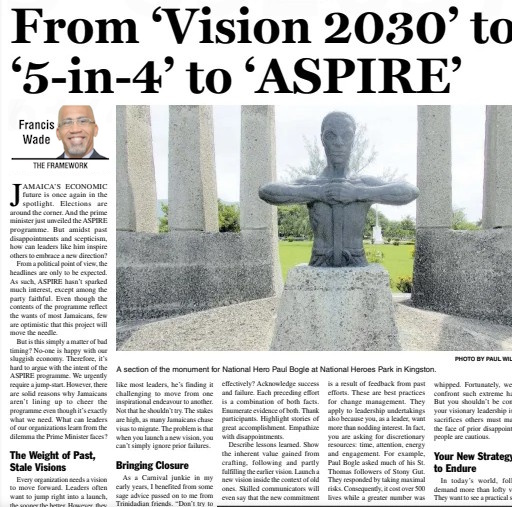Jamaica’s economic future is once again in the spotlight. With elections on the horizon, the Prime Minister has unveiled the ASPIRE program. However, given the backdrop of past disappointments and widespread skepticism, one pressing question arises: How can leaders inspire others to embrace a new direction when another, prior “new direction” is still fresh in people’s memories?
From a political standpoint, the announcement has generated predictable headlines. Unsurprisingly, it hasn’t captured much interest beyond the loyal party base. Despite accurately reflecting the aspirations of most Jamaicans, the ASPIRE program has yet to ignite widespread optimism. Few believe this initiative will significantly alter the economic landscape. But is this response solely due to poor timing?
No one is satisfied with Jamaica’s sluggish economic performance. As such, it’s difficult to argue against the intent behind the ASPIRE program. A revitalized economy is urgently needed. However, the lack of enthusiasm for the program points to deeper issues. What lessons can organizational leaders glean from the Prime Minister’s challenge?
The Burden of Previous Failures
Every organization needs a clear vision to move forward. Leaders often feel an urgency to launch their initiatives as quickly as possible. Yet, in their haste, they sometimes overlook a critical step: addressing the legacy of previous efforts.
When introducing ASPIRE, the Prime Minister bypassed the unresolved struggles of Vision 2030 Jamaica and the unfulfilled promises of the 5-in-4 project. (They were launched in 2009 and 2016 respectively.) This omission is not unique to him; leaders often face difficulties transitioning from one ambitious vision to the next. However, these challenges are amplified when prior efforts have left a trail of unfulfilled expectations.
Jamaicans have seen multiple attempts to rally the nation around shared economic growth objectives. Yet, many remain skeptical, with some pursuing opportunities abroad in search of a better life. The problem lies in the failure to properly address and learn from past shortcomings. When launching a new vision, ignoring previous failures is a mistake that erodes trust and engagement.
Closing the Loop
As someone who enjoyed Carnival in my younger years, I learned valuable advice from Trinidadian friends: “Don’t try to replicate last year’s experience.” Each new event should be approached on its own terms. This wisdom is profoundly relevant to leadership. Humans are at their best when inspired by fresh opportunities rather than weighed down by past successes or failures.
So, how can leaders effectively inspire their teams while navigating the shadows of prior disappointments?
- Acknowledge Successes and Failures: Recognize that each previous effort is a mix of achievements and setbacks. Be transparent about both.
- Celebrate Contributions: Publicly thank participants and highlight stories of dedication and accomplishment. Empathize with those who experienced disappointment.
- Extract Lessons Learned: Share the insights gained from past efforts. Demonstrate the value of those experiences, even if the original goals weren’t fully met.
- Position the New Vision in Context: Frame the new initiative as a natural progression informed by prior feedback. Skilled communicators can emphasize that the new vision is not a rejection of the old but an evolution built on collective experience.
These practices are rooted in effective change management. They not only foster engagement but also encourage the discretionary commitment of time, energy, and attention—resources that leaders depend on to achieve their goals.
Consider historical examples, such as the independence movement in India. Mahatma Ghandi and his followers’ quest for justice called for immense sacrifices, ultimately costing hundreds of lives. While today’s challenges may not carry such dire consequences, visionary leadership still asks for sacrifices. In a climate of past disappointments, skepticism is natural, and leaders must tread carefully.
A New Strategy for Sustained Leadership
In the modern world, people expect more than inspiring rhetoric. They demand a practical strategy that addresses obstacles, such as talent shortages or previous missteps. Followers scrutinize new visions against past outcomes, grappling with two key questions:
- Logical Concerns: What makes this initiative different? Why should it succeed where others failed?
- Emotional Concerns: Do my leaders understand my disappointment? Do they take responsibility for past failures and empathize with my reluctance to trust again?
Launching a new vision without addressing these concerns risks deepening cynicism. Leaders who skip over the logical and emotional barriers of the past will find it increasingly difficult to inspire genuine commitment. Instead, leaders must intervene with honesty, empathy, and a clear plan.
For example, Nelson Mandela’s leadership in post-apartheid South Africa provides a powerful blueprint. Emerging from prison, Mandela confronted the nation’s painful history with sober honesty. His vision of reconciliation didn’t gloss over atrocities but sought to unite both victims and perpetrators under a shared future. His authenticity and empathy helped forge a new path for the country.
Some leaders may argue that achieving results requires force and urgency. However, true inspiration cannot be compelled. To galvanize others toward a bold new future, leaders must address the past openly, demonstrate empathy, and rebuild trust. Only then can they rally people to make the sacrifices needed for transformative change.

